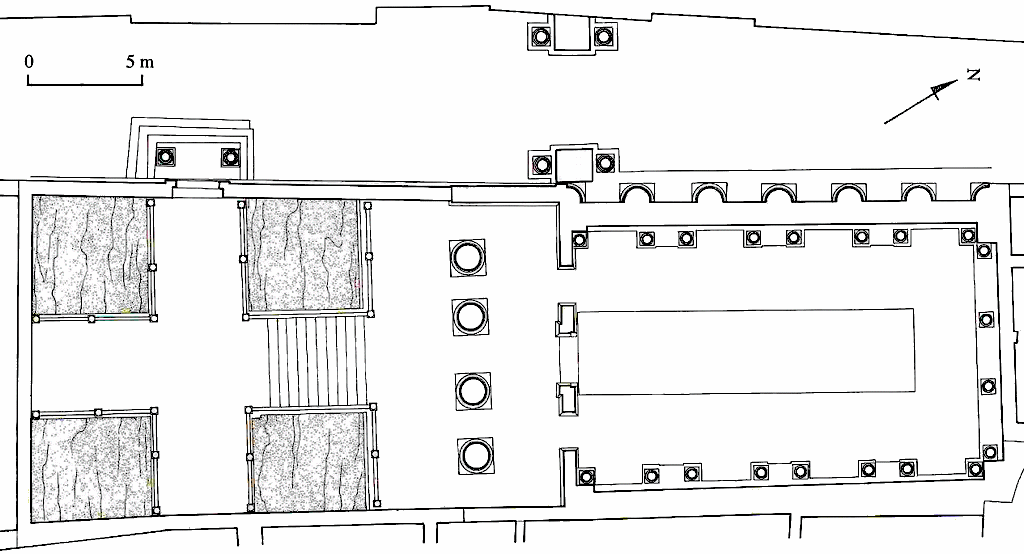In Tunisia four arches from the sole reign of Caracalla are documented. First of all a small and simple arch in Uzappa (Ksour Abd El Malek). Nearby, on the ground, the dedicatory inscription was found. The arch was the work of the Civitas Uzappa, as decreed by the decurions, paid from public funds (decreto decurionum pecunia publica; CIL VIII Suppl. 1, 11929; EDCS-23400751). It cannot be dated more accurately than 211-217 AD.
The arch of Uzappa.
Photo: Leydier 2006, p. 187 fig. 2.In the Civitas Vazitana Sarra (Henchir Bez) an arch was erected as monumental entrance of a temple of Mercurius. A few scant remains of the temple can still be seen. The arch was dedicated to the deified Septimius Severus, Caracalla, Julia Domna and the divine Imperial household in 212 AD by Caius Octavius Rogatus, priest of Mercurius, and his son:
[titulature] C(aius) OCTAVIVS ROGATVS FLAM(EN) P(er)P(etuus) SACERDOS MERC(uri) SVO ET C(ai) OCTAVI ROGATIANI FILI(i) SVI NOMINE ARCVM CVM GRADIBVS SVIS EX LIBERALITATE SVA PECVNIA FECIT ET DEDICAVIT D(ecreto) D(ecurionum) IDEM IAM STATVAM DEO MERCVRIO EX AERE IN PETRA SEDENTEM ITEM OB HONOREM FLAM(inatus) SVI STATVAM IMP(eratori) SEVERO DVPLICATA PECVNIA FECIT [titulature] Caius Octavius Rogatus, perpetual flamen, priest of Mercurius, built with his money in his generosity, in his name and in the name of his son C. Octavius Rogatianus, an arch with its steps, and dedicated it by decree of the decurions. Likewise, he had already given the god Mercurius a bronze statue representing him seated on a rock, and likewise, in honour of being made flamen, by doubling the sum, he had a statue for the Emperor Severus made. The dedicatory inscription of the arch in Vazitana Sarra.
CIL VIII Suppl. 4, 23749; EDCS-24501404. See also CIL VIII Suppl. 1, 12006 and 12007.A third arch is found in the Colonia Iulia Assuras (Henchir Zenfour). It still stands, degraded, but it has been consolidated. It was dedicated by the colonia in 215 AD, to the deified Septimius Severus, Caracalla and Julia Domna (CIL VIII.1, 1798; EDCS-18300177).
The arch in Assuras in a drawing by James Bruce (1730-1794).
Image: Google Arts & Culture.A fourth arch, in Thugga (Dougga), has almost completely disappeared. The arch spanned a street running along the western long side of a temple, with which it forms an architectural entity.
The location of the arch. The column lying on the ground, to the left, belongs to it.
Five columns to the right, of which only the lower part has been preserved, form part of the Temple of the Victories of Caracalla.
Photo: Wikimedia, Pradigue.The temple next to the arch has been identified as the Temple of the Victories of Caracalla, built in 214 AD. It was accessed from the same long side against which the arch was set, along a few steps leading to a courtyard in front of the temple. Four square areas in the courtyard may have been little gardens. A staircase between two of these square areas leads from the courtyard to the temple. The epigraphic evidence belongs to the temple, not to the arch.
PRO SALVTE [titulature] TEMPLVM VICTORIAR[um --- d]OMINI NOSTRI QVOD G[a]BINIA HERMIONA TESTAMEN[to suo ex] HS C M(ilibus) N(ummum) FIERI IVSSIT PERFECTVM ET DEDICATVM ES[t q]VO TESTAMENTO DIE DEDICATIONIS ET DEI[nceps] QVODANNIS EPVLVM DECVRIONIBVS AB HER[e]DIBVS SVIS DARI PRAECIPIT ITEM AGRVM QVI APPELLATVR CIRCVS AD VO[l]VPTATEM PO[p]VLI REI PUBL(icae) REMISIT For the well-being [titulature, of Caracalla and Julia Domna]. The Temple of the Victories ... of our Lord, which Gabinia Hermiona had, in her will, ordered to build for 100,000 sesterces, has been completed and dedicated. In her will she had also prescribed that a banquet would be offered by her heirs to the decurions on the day of the dedication and thereafter each year. Also she gave back to the city the field which is called the circus, for the pleasures of the people. The dedicatory inscription of the temple.
The lower left part of the second r of victoriarum has been preserved.
EDCS-17900394.

Plan of the temple and the arch, set against the centre of the western long side.
Image: Leydier 2006, p. 241 fig. 6.In the lateral niches of the cella were statues of deities. Four socles have been preserved, with dedications to Liber Pater, Mercurius, Neptunus and Apollo (EDCS-11600236-9). On part of an architrave that was above these niches "Minerva" can be read (EDCS-25900230).
Interior of the cella.
Photo: dougga.org.Finally a rather well-preserved set of baths in Dougga has been assigned to Caracalla, thermae Antoninianae. The hypothesis is based on an inscription found nearby, documenting a restoration from the fourth century. The filling of the first lacuna in line 1 is not certain and, if correct, could also point to Marcus Aurelius, but architectural characteristics point to the early third century (porticos with arches supported by columns).
ATRIVM THERMAR[um anton]INIARVM AB ANTIQVIS C[oe]PTVM EXCEP
TORIIS IN EODEM LOCO SV[b]STATIBV[s] QVOD INPERFECTO OPERE CORRVPTVM ADQVE
RVDERIBVS FOEDATUM [erat ---]DIVS HONORATI(a)NVS FL(amen) P(erpetuus) CVR(ator) REI P(ublicae) II [cu]M STATVA
SIGNOQ(ue) FELICISSIM[--- A]VGGG(ustorum) RATV OPERE FECIT ITEMQ[ue dedica]VIT
The inscription from the 4th century mentioning the baths.
EDCS-13100026.
View of the baths.
Photo: Wikimedia, Davide Mauro.